Royal Wedding Shoes: Their Impact on Fashion Trends
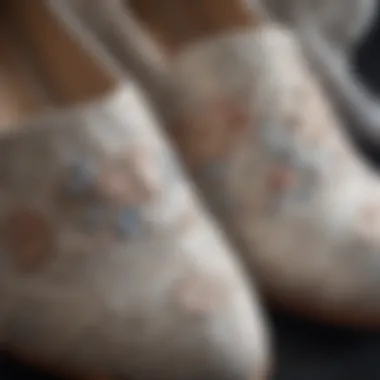
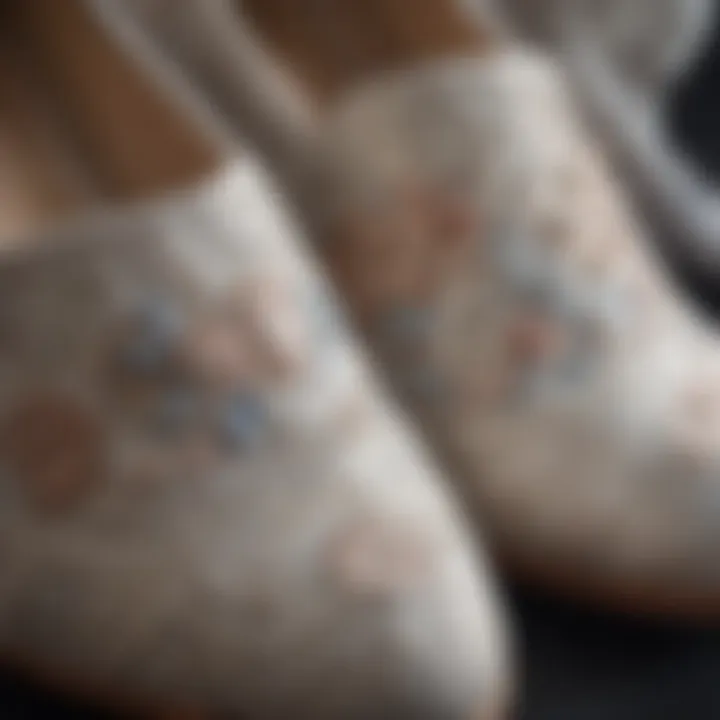
Intro
Royal weddings have long captivated audiences around the globe, serving as milestones in opulent displays of culture and tradition. Each pair of shoes worn by the brides carries not just their individual flair, but also deeper significance that affects modern fashion trends. As the wedding approaches, designers scramble to create footwear that will set the stage for the cultural conversation that follows. The royal family, standing as an emblem of grace, power, and heritage, influences how women perceive fashionably elegant footwear.
Decoding the allure of royal wedding shoes unveils not only the aesthetic pleasure they offer but how they symbolize the intersection of tradition and contemporary fashion. Let's step into this fascinating world and explore the vital role these shoes play—shaping trends, inspiring other fashion sectors, and carving a path towards modernity.
Historical Context of Royal Wedding Shoes
The importance of understanding the historical context of royal wedding shoes lays the foundation for grasping their current influence in fashion. Over the centuries, these shoes have symbolized not just personal style but also social status and cultural values associated with marriage and commitment. The craftsmanship, the choice of materials, and even the colors reflect much about the times they were created in, making them a fascinating topic of study in how fashion communicates deeper meanings.
The interplay between tradition and modernity can often be seen in the evolution of royal wedding shoes, which act as a mirror to wider fashion trends. As such, they provide insights that go beyond aesthetics; they reveal how footwear can encapsulate the essence of an era, capturing the societal shifts as family values evolve and marriage customs transform.
Traditions of Royal Weddings
Royal weddings are steeped in customs that stretch back generations. These traditions keep alive the mythology surrounding royalty, and the shoes are a crucial part of this cultural tapestry. For starters, many royal brides choose white or ivory footwear, reflecting innocence and purity—traits associated with a new beginning in life and the promise of fidelity. The color choices have shifted over time but maintaining a semblance of tradition is key; for instance, Queen Victoria was pivotal in making white fashionable for brides.
Moreover, the shoe’s design often incorporates personal touches. Some royal brides have included family heirlooms or symbols that reflect their heritage within the fabric of the shoe, like embroidered motifs.
In many cultures, the act of wearing specific types of shoes or even the manner in which they are presented to the bride has ritualistic significance. In some traditions, the bride's shoes may be displayed prominently during ceremonies, highlighting their importance not just as part of the outfit but as symbols of status and elegance.
Prominent Historical Examples
Looking through history, there are several iconic examples of royal wedding shoes that stand out vividly. Consider the shoes worn by Princess Diana in her 1981 wedding to Prince Charles. Diana donned a pair of delicate ivory silk shoes adorned with sequins and a slight heel, marrying fashion with a sense of fairy tale royalty. Her choice not only changed wedding shoe aesthetics but set off a wave of brides opting for more elaborate styles in their own nuptials.
Similarly, when Kate Middleton married Prince William in 2011, she wore a pair of custom-made Alexander McQueen shoes, sleek and elegant yet understated. The simplicity showcased a modern approach to royal fashion while still paying homage to the grandeur of royal history.
These examples illustrate how the choices made by royal brides transcend personal style, influencing wedding fashion worldwide. The ripple effect of their decisions infiltrate high street fashion, making royal events a vital touchstone in the evolving conversation of wedding attire and accessories.
"Shoes are the finishing touch on any outfit, but for royal brides, they carry the weight of history and tradition."
By examining these important moments, we better appreciate the depth and significance that royal wedding shoes hold not merely as accessories but also as storytellers of the culture and values of their times.
Design Evolution of Royal Wedding Footwear
The design evolution of royal wedding footwear is more than just a stylistic journey. It serves as a testament to the changing values and aesthetics of society, weaving together threads of tradition, innovation, and cultural significance. Shoes, while they may seem a mere accessory, carry immense weight in the realm of royal weddings, influencing not only the bridal party but also setting the stage for broader fashion trends.
Materials and Craftsmanship
The choice of materials underscores the elegance and luxury associated with royal weddings. Historically, these shoes were crafted from rich materials like silk satin, embellished with intricate embroidery or featuring delicate lace overlays. The care and skill involved in their production often meant that artisans poured significant time into each pair, resulting in footwear that was not only stunning but also unique.
Modern renditions still pay homage to these traditional methods, yet they also embrace innovation. Designers now explore sustainable materials that maintain the lavish appearance expected from royal shoes while promoting ecological responsibility. For instance, the use of vegan leather or recycled fabrics showcases a blend of respect for nature and adherence to royal standards. These choices reflect a growing concern for environmental impact within the fashion industry, making royal shoes both a symbol of status and a voice for change.
In terms of craftsmanship, the artisanal approach has also found its way back into the spotlight. Brands like Manolo Blahnik or Jimmy Choo emphasize handmade techniques, offering bespoke options that capture the allure of exclusivity. Each pair tells a story—be it through the meticulous stitching or the hand-painted finishes—that connects the wearer back to the legacy of grandeur that royal events represent. This transition from mass production to individualized artistry is redefining what it means to wear truly royal footwear.
Influence of Fashion Designers
When it comes to the royal wedding experience, the influence of iconic fashion designers cannot be overstated. Designers such as Alexander McQueen and Sarah Burton have become household names, celebrated for their unique takes on bridal aesthetics. Their creations are often inspired directly by royal themes, blending tradition with modern trends that resonate with a more contemporary audience.
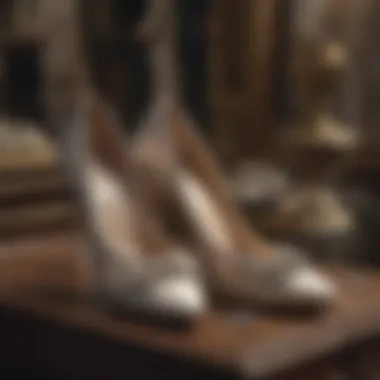
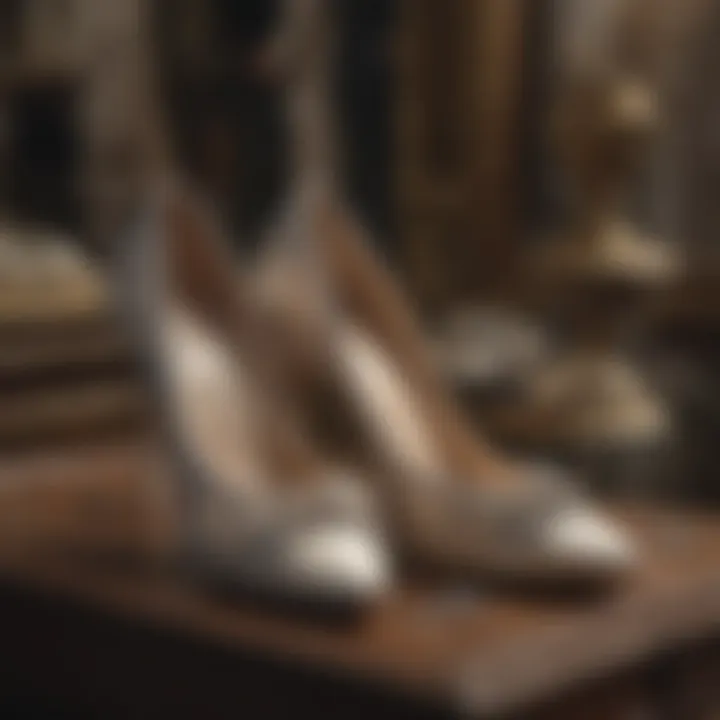
These designers play a vital role in shaping public perception of royal weddings and the associated footwear. For example, Meghan Markle’s choice of Givenchy for her wedding draws attention to how designers can mold fashion narratives. This highlights a fascinating dynamic: the shoes worn on such a monumental occasion can instantly launch trends across the globe, with countless brides-to-be looking to mimic the styles of their royal counterparts.
Additionally, social media influence has ramped up the visibility of these designs, making it easier for emerging designers to break into the scene. Platforms like Instagram and Pinterest allow designers to showcase their work directly to consumers, cultivating a more accessible relationship between the fashion industry and the general public.
Royal wedding shoes have become symbols of inspiration and aspiration, fueling fashion cycles that echo through the high streets and luxury boutiques alike.
"The shoes aren’t just footwear; they are an extension of the wearer's story and ambition, often setting the groundwork for modern women’s fashion globally."
With every royal wedding, the evolution of shoe design continues to reflect societal shifts and stylistic revolutions. Craftsmanship remains at the forefront, with both traditional and innovative materials paving the way toward sustainability in luxury footwear, while the spotlight on visionary designers ensures that these royal narratives remain ever-present in the public eye.
Iconic Royal Wedding Shoes
The realm of royal weddings is often surrounded by grandeur and a sense of tradition, and central to this spectacle is the footwear worn by the brides. Iconic royal wedding shoes not only illuminate the individuality of the brides but also reflect significant elements of culture, history, and fashion evolution. They are more than mere accessories; they hold stories and meanings that resonate with both the royal family and the public.
Royal wedding shoes create a lasting impression that influences many aspects of women's fashion choices. The designs can set off trends that ripple through the fashion industry and into the high street. Observing how styles originated from these royal ceremonies helps craft understanding of their significance. Notably, these shoes often serve as a channel through which designers express their creativity and connection to legacy.
Catherine Middleton's Bridal Shoes
Catherine Middleton, now the Duchess of Cambridge, married Prince William in 2011, and her choice of shoes remains etched in the memory of many. She wore a pair of custom-made Alexander McQueen heels designed by Sarah Burton. These shoes were crafted from ivory satin and incorporated delicate detailing, aligning perfectly with the elegance of her wedding gown. The simplicity coupled with sophistication emphasized her refined personality.
The impact of Kate's shoes extended beyond just fashion; they set off a wave of similar styles across bridal shops around the world. Women began flocking to boutiques in search of shoes that echoed the same classic elegance. Even more fascinating is the durability of the trend. To this day, many brides look to Middleton’s style as a touchstone for creating their own unique bridal aesthetics.
"Catherine's shoes encapsulate the bride’s desire for glamour intertwined with authenticity."
Meghan Markle's Fashion Statement
When Meghan Markle, the Duchess of Sussex, walked down the aisle to marry Prince Harry in May 2018, she also made a powerful fashion statement with her choice of bridal shoes. Markle opted for Givenchy heels, designed by Claire Waight Keller, which featured a sleek, minimalist design crafted from silk. The shoes’ understated elegance complemented her modern take on the traditional royal wedding attire, showcasing individuality and careful thought about her fashion choices.
Markle's shoes went beyond aesthetics; they represented a fresh outlook on royal fashion. Women all over started embracing the idea of simplicity and functionality in their footwear choices, steering them away from overly elaborate or high-heeled styles that had dominated bridal wear for decades. This choice signified a shift in contemporary fashion, where comfort and personal style began to take precedence.
In summary, both Catherine Middleton and Meghan Markle have left a mark on the royal wedding shoe landscape. Their choices reflect personal styles while also influencing wider trends. As we scrutinize royal weddings' effects on fashion, it becomes clear that these shoes significantly contribute to evolving narratives within women’s fashion.
Cultural Significance of Footwear in Royal Weddings
Royal weddings often mesmerize audiences worldwide, sparking both excitement and a surge of interest in fashion. Central to this spectacle, yet sometimes overlooked, is the footwear. The cultural significance of shoes in royal weddings goes beyond mere aesthetics; it weaves a rich tapestry of tradition, symbolism, and influence over contemporary fashion.
Symbolism of Shoes in Marriage
When it comes to marriage, shoes can carry immense meaning. They may represent the journey of the couple, with every step symbolizing progress in their life together. Traditionally, during a wedding ceremony, the bride’s shoes have been personalized, embodying her style, heritage, and even aspirations. This aspect can be seen in the choice of materials. For instance, satin shoes may denote luxury, while shoes crafted from leather might symbolize durability and strength.
Moreover, the color of wedding shoes often reflects age-old beliefs and superstitions. White, for instance, is a color that denotes purity and new beginnings. However, in various cultures, red could symbolize prosperity and fertility. Thus, asymmetrically lacing one’s shoes while getting married could represent the binding of two lives. This symbolic act, therefore, isn’t merely an accessory but rather an integral part of the marital narrative.
"In many cultures, shoes are more than just footwear; they are symbols of status and intention, especially during momentous occasions like royal weddings."
Cross-Cultural Perspectives
The significance of footwear in royal weddings stretches across borders, illustrating diverse cultural beliefs and practices. In some Asian cultures, for example, shoes hold a powerful status in wedding rituals. In many Indian weddings, the bride’s shoes are often adorned with intricate designs. They can even become a playful focal point during the ceremony, with relatives attempting to hide them, expecting the groom to negotiate a playful ransom to retrieve them.
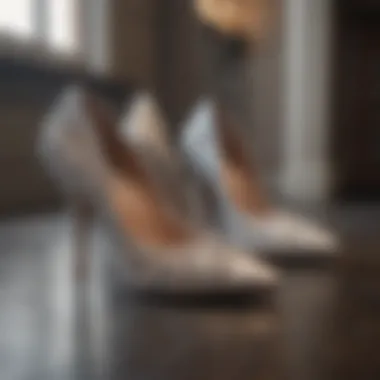
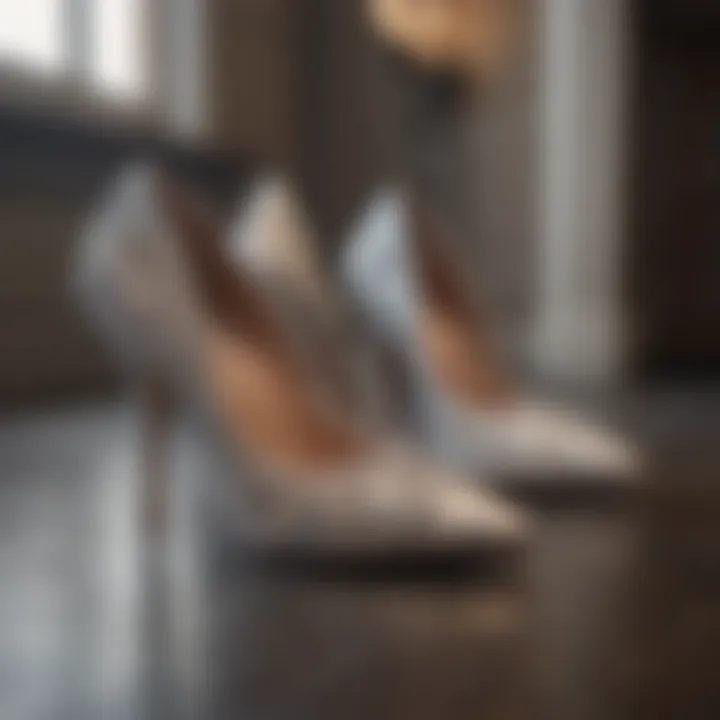
In contrast, in Western traditions, shoes have undergone an evolution from ornate designs of historical periods to sleek modern interpretations. A notable example is Kate Middleton’s choice of L.K. Bennett Sledge pumps for her marriage to Prince William—this leap towards trendy yet classic styles mirrored the evolving views on royal fashion.
The techniques used in creating these shoes also tell a story of culture, whether it’s the delicate embroidery on shoes used in Thai weddings or the vintage craftsmanship in Italian bridal footwear. Each design and stitch carry a narrative reflecting the history behind the marriage customs. Considering all these perspectives enhances one’s appreciation for the nuance embodied in footwear used during royal celebrations.
This exploration of the cultural significance highlights how royal wedding shoes serve not only as fashion statements but as vessels of tradition, identity, and the collective hopes for the future intertwined in the act of marriage.
Impact on Contemporary Fashion Trends
The influence of royal wedding shoes on modern fashion trends is a compelling topic that deserves close scrutiny. These footwear choices made during high-profile ceremonies are not simply part of a dress; they often carry with them connotations of status, elegance, and the latest in fashion innovation. When a royal figure steps out in a particular style of shoe, the ripples can be felt across the world, impacting retailers and designers alike. Understanding this influence assists in appreciating how tightly woven the threads of royal fashion and consumer preferences really are.
Influence on High Street Fashion
High street fashion, known for its accessibility and affordability, often takes cues from high-profile events. Royal wedding shoes, with their exquisite detail and unique craftsmanship, tend to forge trends that trickle down into the everyday wardrobe. For example, when Catherine Middleton chose a pair of suede heels by Alexander McQueen, soon after, similar styles started popping up in shops from Zara to H&M. Shoppers, always looking for ways to incorporate a touch of glamour into their lives, often replicate these royal choices on a smaller scale.
Furthermore, brands frequently adapt these styles to cater to the masses. They incorporate elements from royal footwear, such as color schemes, embellishments, or heel heights, striving to create an affordable yet premium-looking product. By analyzing these adaptations, one can discern a direct connection between royal events and the evolving landscape of mainstream fashion.
Social Media's Role in Setting Trends
Social media has transformed the way trends are perceived and propagated. Platforms like Instagram and TikTok serve as the modern-day bullhorns for fashion enthusiasts. When a royal wedding takes place, it’s almost a given that images of the bridal ensemble, shoes included, will inundate social media feeds worldwide. Influencers quickly share their takes on royal styles, breaking down the latest trends for their followers, which elevates the visibility of royal wedding shoes exponentially.
Additionally, hashtags related to specific royal events frequently trend, bringing public attention to the finer details of footwear. Posts on platforms like Facebook and Reddit breed conversations around design choices and potential replicas, leading to the creation of countless tutorials and fashion guides that emphasize how to capture that royal essence in a non-royal budget.
The collective response from the audience further solidifies the shoes' significance. Consumers often seek to embody the elegance of royalty in their own ways, demonstrating social media's capacity to bridge the gap between the elite and everyday style.
"Royal wedding shoes don’t just walk down the aisle; they pave the way for trends that influence everyday fashion choices across the globe."
As these dynamics unfold, it becomes evident that the impact of royal wedding shoes extends well beyond the ceremony itself. They serve as a manifestation of cultural zeitgeist, guiding discussions around aesthetics and aspirations while shaping the landscape of contemporary fashion.
Sustainable Choices in Royal Fashion
The conversation around sustainability has been bubbling up like a pot on the stove, gaining heat and attention in the fashion world. When it comes to royal weddings, these events do more than just set fashion trends; they also provide a platform to advocate for environmentally conscious practices. Royal wedding shoes, in particular, are no longer just a statement of luxury; they’ve come to represent a shift in how we perceive and prioritize sustainable fashion. The emphasis on sustainable choices in royal fashion reflects a broader societal push towards responsibility and ethics in consumerism. In essence, this section dives into how royal families are making sustainable choices not just for the sake of appearance but as an integral part of their value systems.
Eco-Friendly Materials
In the quest for sustainability, the choice of materials becomes crucial. Gone are the days when royal shoes were purely about high-gloss satin and sparkling embellishments. Today’s royal wedding footwear sees a significant pivot towards eco-friendly materials.
- Recycled Fabrics: Designers are leaning into materials like recycled satin, which not only retain elegance but also reduce waste. This is a statement about how high fashion can rise recycled from its own remnants.
- Natural Dyes: Instead of synthetic dyes that can be harmful to the environment, some royals are opting for shoes dyed with natural pigments, sourced from plants. This not only minimizes chemical use but also supports natural farming.
- Vegan Leather: A movement is afoot towards non-animal derived materials. For example, shoes made from pineapple leather or apple leather are starting to appear in royal events. A far cry from traditional leather, they are innovative and kinder to our four-legged friends.
Employing these materials is more than a fashion statement; it promotes awareness about environmental impact while still keeping the aesthetics in check. Additionally, it encourages consumers to think critically about what encases their feet.
The Shift Towards Ethical Fashion
The winds of change are steering the boat towards ethical fashion, particularly in situations as visible as royal weddings. Ethical fashion pertains to how goods are produced, addressing the labor practices and conditions involved in crafting those luxurious pieces.
The royal embrace of ethical fashion has several layers:
- Transparency in Production: Royals are starting to showcase the story behind their footwear. Knowing where a pair of shoes comes from, who made them, and how they were made introduces a new model of consciousness in fashion. This kind of transparency nurtures consumer trust and paves the way for informed choices.
- Supporting Local Artisans: Some royal brides have chosen to wear shoes made by local artisans or designers, which not only promotes the craftsmanship but also stimulates local economies. It's like giving a leg-up to small businesses while draping yourself in elegance.
- Promoting Slow Fashion: The rise of slow fashion is akin to a thick gravy: rich, comforting, and layered. Royal weddings that focus on sustainability support this movement by opting for timeless designs rather than fast trends. They encourage consumers to invest in quality footwear that is made to last, rather than chasing ephemeral styles that end up gathering dust.
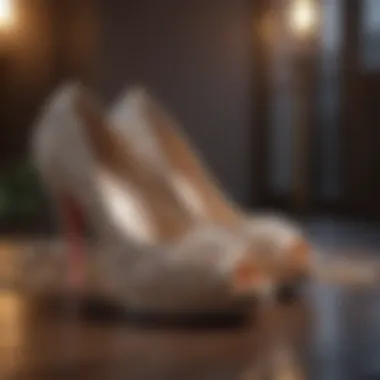

"A sustainable shoe isn’t just good for the earth; it’s a conversation starter at a dinner party."
In combining these principles, royal wedding shoes not only command attention for their visual appeal but also for their ethical standing. They challenge the status quo and invite us to reconsider what we place value in when it comes to fashion choices. With the royal spotlight on sustainability, they refuse to let fashion merely be about excess but instead highlight their commitment toward a responsible future.
Consumer Perspectives on Royal Wedding Shoes
Consumer perspectives on royal wedding shoes serve as a vital touchstone within the broader context of fashion evolution. These shoes are not just accessories; they’re markers of social status, taste, and personal expression. In an age where individuality matters more than ever, the fascination with royal wedding footwear reflects a complex blend of aspiration, reverence, and accessibility. The shoes worn by royal brides are closely watched, analyzed, and even emulated, adding layers of significance that go beyond mere appearance.
Aspirational Fashion vs. Reality
When it comes to royal wedding shoes, there's often a crucial divide between aspiration and reality. Many consumers look at the luxurious, often bespoke shoes worn by royalty and dream of the grandeur that comes with them. For instance, consider the iconic Alexander McQueen heels that Catherine Middleton sported at her wedding—sleek, elegant, and undeniably high-status. These shoes are not easily accessible, and their price points are far from what the average woman would pay for a pair of pumps.
However, inspired by these royal choices, brands frequently produce more affordable versions of high-fashion designs, enabling the masses to partake in this aspirational trend. Large retailers like ASOS or Zara roll out lines inspired by royal wedding fashion, making it possible for everyday consumers to step into a piece of glamour without breaking the bank.
Key Elements of Aspirational Fashion:
- A desire to emulate royal elegance
- Increased interest in high-end designers
- Fashion collaborations aimed at capturing royal style
But there’s also a contradiction at play. While many admire and adore the splendor of royal footwear, the reality is that the investment in such luxury items may not align with their practical needs or financial capability. This chasm leads to interesting conversations about consumer priorities. Are they aiming to feel part of the royal narrative, or is it all about the aesthetic? The duality of wanting something exclusive while grappling with everyday realities enriches the discussion surrounding royal wedding shoes.
Market Trends and Consumer Choices
The market trends surrounding royal wedding shoes highlight changing consumer choices that reflect broader societal shifts. Young women today are more in tune with sustainability and ethical practices than previous generations. In fact, 50% of consumers in a recent survey indicated they would pay more for sustainable options, even when it comes to luxury items such as wedding shoes. This paradigm shift influences what designers create, urging them to consider eco-friendly materials and ethical labor practices.
As a result, we’re starting to see an emergence of new brands that prioritize sustainability while still capturing the essence of royal elegance. For example, brands like Veja and Allbirds are making efforts in sustainable footwear that may not scream "royal" but resonate with consumers who value ethical practices just as highly as aesthetics.
Trends Shaping Consumer Choices:
- Increased demand for sustainable and ethical footwear
- A desire to balance tradition with modern values
- The rise of social media showcasing personalized styles
Moreover, social media platforms have become a breeding ground for these trends. Platforms like Instagram and TikTok influence what consumers buy by showcasing how real women incorporate elements of royal style into their lives. This trend-forward attitude allows consumers to blend aspiration and reality—allowing everyone to partake in the royal narrative, in their own way.
In summary, the significance of consumer perspectives on royal wedding shoes is multi-faceted. It reveals not only the aspirational nature of fashion but also highlights the evolving priorities of modern consumers, making this topic immensely relevant in today’s fashion discourse.
Future Directions in Royal Footwear Fashion
As we look to the future, the realm of royal wedding shoes appears poised for exciting transformations. The significance of this topic lies not just in its aesthetic appeal, but also in how these shoes interlace with broader cultural dynamics, shaping trends that ripple through the entire fashion landscape. Emerging designers are increasingly creating collections that reflect the desires of both the haute couture enthusiast and the everyday consumer. Additionally, the influence of technological advancements is sure to play an essential role in redefining what is possible in shoemaking.
Emerging Designers and Trends
New talent is surfacing in the footwear design scene, and their perspectives are refreshing. Emerging designers are often unconstrained by the conventions established by their predecessors, which means they can take risks and introduce innovative ideas. By blending traditional craftsmanship with modern concepts, these designers are pioneering unique styles that resonate with younger generations.
For instance, consider the likes of Charlotte Olympia and Sophia Webster, who have redefined femininity in footwear with whimsical and bold designs. Their creations often evoke a sense of wonder, making a statement that transcends mere functionality. Moreover, many of these new designers emphasize individuality, encouraging brides to view their wedding shoes as an extension of their personal style rather than mere accessories.
The inclusion of vibrant colors, unconventional shapes, and playful elements is both refreshing and inclusive, accommodating various tastes and wedding themes. In a way, these shoes become a canvas for self-expression, allowing brides to reflect their history, culture, and even personal stories.
Technological Innovations in Shoemaking
As we venture deeper into the digital age, technological innovations in shoemaking emerge as another pivotal aspect shaping the future of royal wedding shoes. From 3D printing to smart materials, the shoemaking industry is on the brink of a revolution. For instance, the advent of 3D printing enables designers to create intricate patterns and structures that were previously unimaginable. This process not only reduces waste but also opens doors for custom fittings, ensuring each pair is uniquely suited to the bride’s feet.
Furthermore, the integration of smart materials plays a crucial role in enhancing comfort. Shoes that adapt to the wearer's movements, temperature, and even the surface they walk on can be achieved through advanced engineering. The potential for combining style with state-of-the-art functionality is enormous, offering a glimpse into a world where tradition meets innovation.
"The royal wedding shoes of tomorrow will not only dazzle with their beauty but also provide unprecedented comfort and adaptability to their wearers."
As these technological advancements continue to evolve, we may see royal wedding shoes that go beyond adornments to become essential partners in the bridal journey, allowing wearers to focus more on their big day rather than on discomfort or styling issues.



